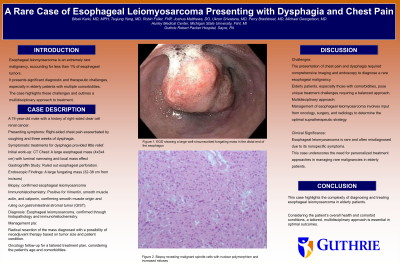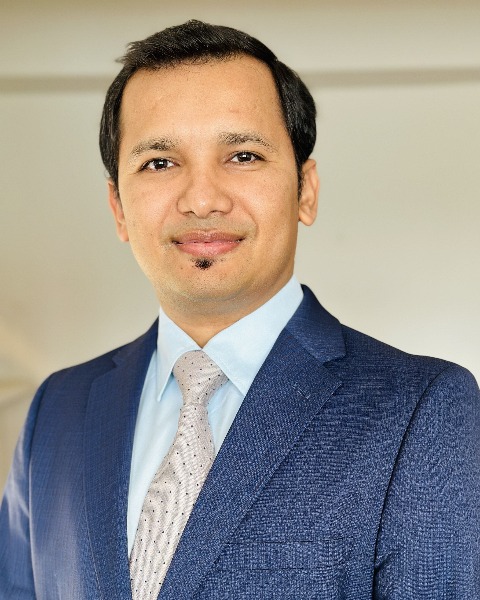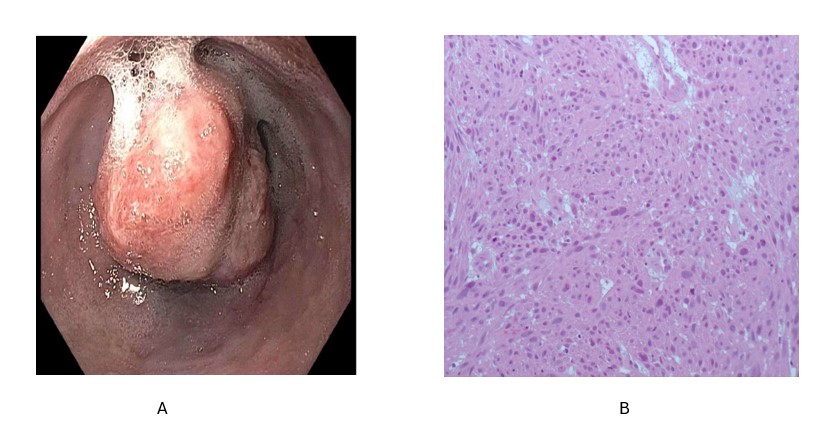Tuesday Poster Session
Category: Esophagus
P3983 - A Rare Case of Esophageal Leiomyosarcoma Presenting With Dysphagia and Chest Pain: A Case Report
Tuesday, October 29, 2024
10:30 AM - 4:00 PM ET
Location: Exhibit Hall E

Has Audio

Bibek Karki, MD, MPH
Hurley Medical Center
Grand Blanc, MI
Presenting Author(s)
Bibek Karki, MD, MPH1, Tsujung Yang, MD2, Robin Fuller, FNP2, Joshua Mathews, DO2, Ukorn Srivatana, MD2, Perry Bradstreet, MD2, Michael Georgetson, MD2
1Hurley Medical Center, Flint, MI; 2Guthrie Robert Packer Hospital, Sayre, PA
Introduction: Esophageal leiomyosarcoma is a rare malignancy that presents significant diagnostic and therapeutic challenges, particularly in elderly patients with multiple comorbidities.
Case Description/Methods: A 74-year-old male with a history of right-sided clear-cell renal cancer presented with a complaint of right-sided chest pain exacerbated by coughing, associated with dysphagia for three weeks. Despite different symptomatic treatments, the difficulty swallowing persisted. CT chest revealed a large esophageal mass measuring 4x3x4 cm with significant luminal narrowing and local mass effect. Gastrograffin study ruled out esophageal perforation. Further evaluation through esophagogastroduodenoscopy (EGD) confirmed the presence of a partially obstructing large fungating mass in the middle third of the esophagus, spanning 32 cm from the incisors to 38 cm distally, and biopsies were obtained. Pathological examination revealed esophageal leiomyosarcoma with immunohistochemical staining positive for vimentin, smooth muscle actin, and calponin, confirming the origin of tumor cells to be smooth muscles and excluding a gastrointestinal stromal tumor (GIST). Management strategies discussed included radical resection of the mass, with consideration of neoadjuvant radiation therapy based on tumor size. Follow-up consultations with oncology specialists were arranged to determine the optimal treatment plan. This case underscores the rarity of pathology itself with diagnostic and therapeutic challenges posed by esophageal malignancies in elderly patients.
Discussion: The presentation of chest pain and dysphagia necessitated thorough imaging and endoscopic evaluations, ultimately revealing a rare esophageal leiomyosarcoma. The management plan, including potential radical resection and neoadjuvant radiation therapy, reflects the need for a multidisciplinary approach to balance treatment efficacy with the patient’s overall health and comorbid conditions. This case emphasizes the importance of tailored therapeutic strategies and close collaboration among healthcare specialists in managing complex malignancies.

Disclosures:
Bibek Karki, MD, MPH1, Tsujung Yang, MD2, Robin Fuller, FNP2, Joshua Mathews, DO2, Ukorn Srivatana, MD2, Perry Bradstreet, MD2, Michael Georgetson, MD2. P3983 - A Rare Case of Esophageal Leiomyosarcoma Presenting With Dysphagia and Chest Pain: A Case Report, ACG 2024 Annual Scientific Meeting Abstracts. Philadelphia, PA: American College of Gastroenterology.
1Hurley Medical Center, Flint, MI; 2Guthrie Robert Packer Hospital, Sayre, PA
Introduction: Esophageal leiomyosarcoma is a rare malignancy that presents significant diagnostic and therapeutic challenges, particularly in elderly patients with multiple comorbidities.
Case Description/Methods: A 74-year-old male with a history of right-sided clear-cell renal cancer presented with a complaint of right-sided chest pain exacerbated by coughing, associated with dysphagia for three weeks. Despite different symptomatic treatments, the difficulty swallowing persisted. CT chest revealed a large esophageal mass measuring 4x3x4 cm with significant luminal narrowing and local mass effect. Gastrograffin study ruled out esophageal perforation. Further evaluation through esophagogastroduodenoscopy (EGD) confirmed the presence of a partially obstructing large fungating mass in the middle third of the esophagus, spanning 32 cm from the incisors to 38 cm distally, and biopsies were obtained. Pathological examination revealed esophageal leiomyosarcoma with immunohistochemical staining positive for vimentin, smooth muscle actin, and calponin, confirming the origin of tumor cells to be smooth muscles and excluding a gastrointestinal stromal tumor (GIST). Management strategies discussed included radical resection of the mass, with consideration of neoadjuvant radiation therapy based on tumor size. Follow-up consultations with oncology specialists were arranged to determine the optimal treatment plan. This case underscores the rarity of pathology itself with diagnostic and therapeutic challenges posed by esophageal malignancies in elderly patients.
Discussion: The presentation of chest pain and dysphagia necessitated thorough imaging and endoscopic evaluations, ultimately revealing a rare esophageal leiomyosarcoma. The management plan, including potential radical resection and neoadjuvant radiation therapy, reflects the need for a multidisciplinary approach to balance treatment efficacy with the patient’s overall health and comorbid conditions. This case emphasizes the importance of tailored therapeutic strategies and close collaboration among healthcare specialists in managing complex malignancies.

Figure: Fig A shows the upper endoscopic finding of a large well-circumscribed fungating mass in the distal end of the esophagus. Fig B shows a microscopic finding of malignant spindle cells with nuclear pleomorphism and increased mitoses.
Disclosures:
Bibek Karki indicated no relevant financial relationships.
Tsujung Yang indicated no relevant financial relationships.
Robin Fuller indicated no relevant financial relationships.
Joshua Mathews indicated no relevant financial relationships.
Ukorn Srivatana indicated no relevant financial relationships.
Perry Bradstreet indicated no relevant financial relationships.
Michael Georgetson indicated no relevant financial relationships.
Bibek Karki, MD, MPH1, Tsujung Yang, MD2, Robin Fuller, FNP2, Joshua Mathews, DO2, Ukorn Srivatana, MD2, Perry Bradstreet, MD2, Michael Georgetson, MD2. P3983 - A Rare Case of Esophageal Leiomyosarcoma Presenting With Dysphagia and Chest Pain: A Case Report, ACG 2024 Annual Scientific Meeting Abstracts. Philadelphia, PA: American College of Gastroenterology.
